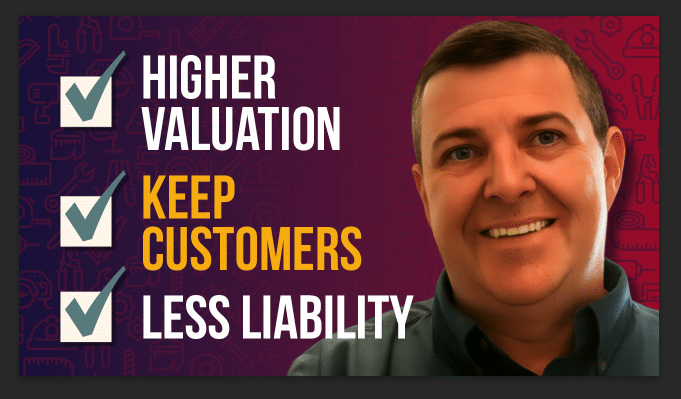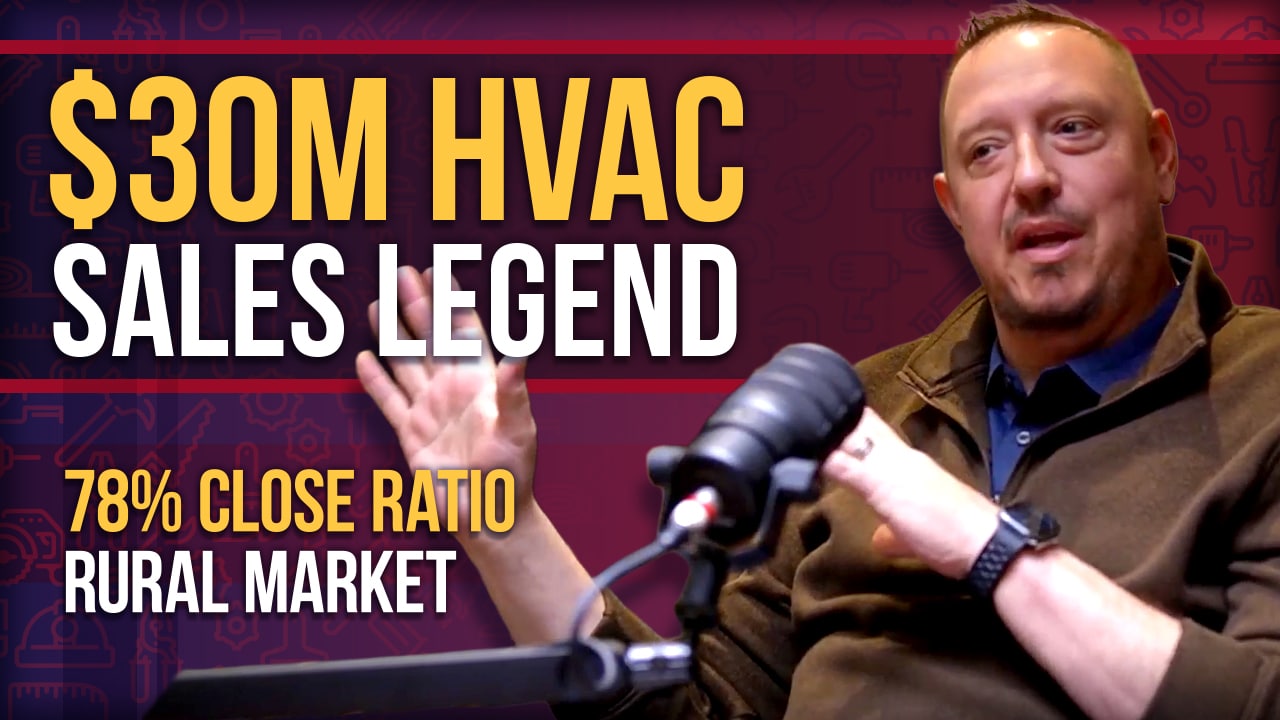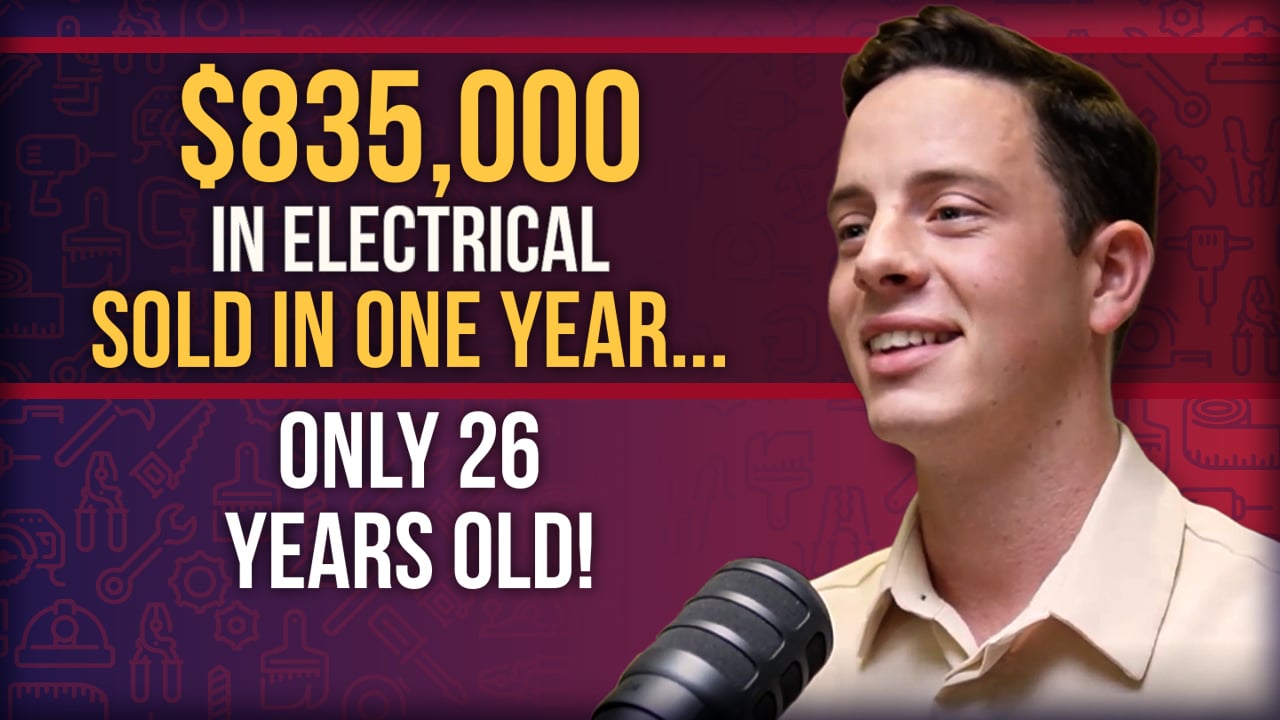Brent Stowell, and His Four Sons, Jon, Jake, Justin & Jesse, Have Guided the Company to This Incredible Growth by Learning to Delegate Responsibility, Building a Strong Operation & Investing in Hiring & Growing the Right People.
This story is an approximate transcription of a “The Successful Contractor” podcast interview. “The Successful Contractor” podcast, powered by Success Group International, is a show for residential contractors about residential contractors. It chronicles business journeys, shares insights, and celebrates successes in this wonderful industry of the trades and tradespeople.
Five Guys Home Services, formerly Five Guys Roofing, in Gilbert, Arizona, is owned by the Stowell family: father, Brent, and his four sons, Jon, Jake, Justin, and Jesse. In 2019, Five Guys hit an impressive $14.5 million in revenue, at a strong profitability—a massive accomplishment, considering as recently as 2015, the company was generating $3.3 million.
What was biggest reason for Five Guys’ quick and immense upward growth? It began with Brent entrusting his sons to take over core responsibilities of the business. And then Jon, Jake, Justin, and Jesse finding great people to serve as managers and entrusting them to take additional responsibilities from them. This process of each of the five guys constantly finding people to replace themselves has allowed them to truly hone their operation.
Long-term success requires more than strong business practices. Brent, Jon, Jake, Justin, and Jesse have a genuine, heartfelt interest in their team’s happiness and success. That desire has served as the backbone of Five Guys’ culture. No company can quadruple its revenue in four years, while also remaining highly profitable—without an entire team working together as one.
Why the decision to join SGI many years ago?
Jon: In 2010, there was a hailstorm that came through, and you’re talking about a storm that never hits Arizona. It created upwards of $2 billion in roofing damage. And so, that created a pretty big influx of work through 2010 and 2011. As that started to slow down, we knew we needed some help. We didn’t know what that help was, but we got a card in the mail from SGI asking us to attend a Profit Day™. So, Jake and I went to that Profit Day™ and were thoroughly impressed with the content, the training, and just the whole program. We signed up and wrote a check that I don’t think I probably should have written at the time and then called my dad and said, “Hey, guess what we did?” [Laughter]
That was the first time that we signed up. We tried to implement some things. Obviously, it was quite a bit different than how we were currently operating. And so, there was a lot of changes and a lot of training that was needed. Then we hit a huge bump. Actually, during one of the trainings, in St. Louis… Dad, do you want to share it?
Brent: We had gone back to St. Louis for a training for a week, and I had some health issues. It ended up being a bleeding ulcer. I ended up in the hospital. This was 2013. I ended up in intensive care. I coded twice in 24 hours. It was a dark time for us as a family—and our company, too. We came back, and the boys were trying to put things back together and figure out where are we going to go. At the same time, they’re worried about dad. It was a tough time. Then, later that same year, I had to have open heart surgery.
So, we lost direction there for a little while as the boys were struggling to keep everything going in the right direction, and not really knowing where we were. We hadn’t come up with an ownership agreement. There was no real transition of ownership or management, and so we were kind of lost there for a while. And I believe it was in the beginning of 2014 that we ended up pulling away from SGI and trying to figure out where we were going to go and what we were going to do.
So, you left SGI in 2014 but came back in 2015. Why?
Jake: I think it was a combination of a few different things. I don’t think we ever wanted to leave. I think it was money. I think it was just direction and trying to figure things out. And I think we quickly realized we were missing a piece that we liked. When Jon came back from his hiatus in 2016, he mentioned the idea of rejoining, and it happened pretty quick. At that point, our sales were steadier, and we felt we were in a better position to get back into the RSI model. Check out the SGI Membership Difference Here.
When did the name change to Five Guys happen?
Jon: It was in 2012 after attending Executive Perspective™ as Western Foam. We left and decided to completely rebrand. That was one of our BHAGs (Big Hairy Audacious Goals).
Brent: Let’s back up to 2010. Prior to that, we had only done foam roofing. And in 2010, when we had the hailstorm, we were quickly pushed into other kinds of roofing. So, when we went to Executive Perspective™ in 2012, we realized that Western Foam didn’t match what we do and we needed to rebrand.
Going back to that first Executive Perspective™, what did you think leaving that week?
Jake: I think there was a lot of things that we thought of—but didn’t change or didn’t know how to change it. So, I think that during Executive Perspective™, a lot of light bulbs go off. I also remember it being a really emotional time for us. I remember, my dad’s a pretty emotional guy, and I do remember it, at the end of the conference and in tears about finding SGI and kind of where we were at as a company. I thought it was a game-changer for us.
Jon: Up to that point, I had never looked at a profit and loss. In fact, I couldn’t even tell you what the acronym stood for. [Laughter] So looking at it, and recognizing the impact of managing by the numbers, it was a huge takeaway. Getting back and getting involved with our accountant and trying to figure out how to classify and departmentalize things. Seeing what that could do for our business. It was so impactful.
Brent: I still get emotional about it, because when we went to Executive Perspective™ it was the first time that I met Paul [Riddle, former Vice President of Operations for SGI, who passed away in 2017]. Paul was over the top. He was amazing. He and I connected from day one. We had dinner together and the conversations that we had, the challenges that he gave me—personally, not only as a business owner, but as a father of boys—it all rang true for me. He gave me a vision of where we could be and gave me a responsibility to get there. So, when I left, we had thrown away that $2-million-a-year ceiling, and I realized that I had a responsibility to grow a company that was big enough, not only for me and my boys, but for every employee that we ever brought into our company. We had a responsibility to run it in such a way that it was profitable, so it would bring income and emotional stability to their lives as well. That’s been a big thing for me since that very first day.
How did you approach implementing the RSI model initially?
Jon: It became a focus of mine to figure out the model first and the changes we needed to make. We spend a lot of time with our pricing and StraightForward Pricing®, looking at the Overhead Care Club™, looking at marketing. It was definitely a mutual effort. I remember sitting in a lot of meetings with Jake and Brent talking about priorities. I don’t know if it was right, but we definitely took a shotgun approach and tried to do as much as we could. [Laughter]
Jake: Truck wraps—at least stickering them at first—helped. We needed a presence. We got our logo on as many things we could. I remember getting uniforms—that was a big one. I don’t think we made the full change until about three or four years ago. For example, we completely departmentalized our books and have come to understand our financials.
Back then, I remember the impacts on the sales side. I needed a different mindset. I needed to stress presenting value and beginning to charge for repairs. Prior to SGI, we didn’t charge a dime for repairs! We looked at it as a way to gain a relationship and get a replacement down the road. Leaving that first EP, I knew we had to start charging for repairs and how that would become a significant part of our business.
Brent: I think Executive Perspective™ gave us a perspective of where we could be and where we should be. I think it solidified in our minds the potential that we weren’t tapping. And I think most of us in the contracting business, we really don’t set real high goals, and we don’t look far down the road. If we’ve got work for the next week or two weeks or months, we always feel pretty good about doing things. If the phone’s ringing, and there’s storms coming, we’re good. So, I think the perspective that it gave us—of what it could be—EP solidified that. We had a roadmap.
You invested in training right away, correct?
Brent: Yeah. I always raised my boys that they needed to figure out what they wanted to do, then figure out what it takes to be the best in that industry. SGI brought that to us. They provided the training we needed to be the best in our field. So, we were willing to invest in training right away. We did as much of it as we could. Learn more about SGI’s Learning Alliance.
When you came back to SGI, where was the business at that point financially?
Justin: We had gotten a little larger. We were around $3.3 million.
You were at $3.3 million and today you’re more than four times that. How did you escalate the growth of the business so quickly?
Brent: I think the most significant change that I made was to let go—to outline the responsibilities and then make other people responsible for them. In 2015, 2016, I started turning stuff over to my boys and then watched them. Since then, it’s been them letting go of responsibilities and putting others in charge of them. We’ve had to bring in good people and train them to be successful. The more successful you can help others be, the more successful you’ll become.
Jake: I’ll chime in. I was selling as much as I could. Jesse and Justin were running production and got into sales because we needed the sale. But the big thing was getting ourselves to a point where we could allocate the funds in our P&L—to, number one, get Jon to come back and work with us again. I think that was a huge step, so he could manage the business at a different level. Two, then, it was bringing in, again, more good help so we could elevate what we were doing.
Every year or two, you’d find yourself in a role and feel stuck in it. Not by choice, just because that’s what the business needed. We’ve been able to take more leaps of faith the further along in the process we’ve gotten. [You give that job to someone else and change to another job.] To change is hard, but in the end, it’s good for the business. The last three years, we’ve made a lot of leaps of faith. Those changes have gotten us to where we are.
Justin: A lot of it comes down to getting the right people in the right seats, obviously. And I think the biggest thing we were lacking in 2016 was having somebody that was in the office looking at the entire company as a whole instead of just productions and just sales. So, when Jon was able to come back and provide that perspective, it helped. Jon has the unique quality of being able to sit in an office all day and the rest of us cannot. [Laughter.] That was a key turning point. And it allowed us all to settle into jobs that we’re good at. Jake, still, is the best salesman we have, by far. Jake’s able to sell all day, every day. Jesse and I have been able to fall into the roles where we’re needed for now. It’s easier to grow when you have more people involved that you can trust. As the company has gotten larger, I feel like it’s been easier to make changes because we’ve had the buy-in of so many people, and we all keep each other accountable. Back in 2012, it was just a few of us.
Jon, your name has been mentioned a few times now. When you came back to the business, what could you see that needed to change?
Jon: When I first came back, we were doing hardly any marketing. So marketing was the first thing that I kind of tackled, not necessarily because I was the best at it, but it was just a need. And I was fortunate that my brothers and my dad put me in a position to where I could focus on the business. Going back the previous 25, 30 years, with my dad, for him to sell the work, complete it, and then work until two o’clock in the morning—it’s not sustainable. So, the biggest thing for me was having the time to work on the business, being able to look at it, and then having the time to fix it. I don’t see myself as brilliant or any smarter than the next guy. I’m pretty average if you ask me. [Laughter]
You all mentioned finding good people and giving them responsibilities as a key to growth. How are you finding good people?
Jon: It’s a joint effort. All of us understand the impact that it can make when you find a good person who has the right buy-in and the right morals and ethics. And I think we’re constantly looking for that next person to come in and help. I wish I could give you the secret sauce to it, but I can tell you when you associate with the right people, you’re going to attract the right people. That’s the one thing that we do well. I think my brothers probably do even better than I do. But finding people who you enjoy being around and then being willing to step a step in the dark with them and take that leap of faith with them. My dad says this a lot—he says, “Once you find a good person, figure out how to get them in the door and then figure out what their right seat is.”
What’s your interview process like?
Jon: We’re perfecting that process now. Right now, they get an email thanking them for their [employment] submission. Then, within a day, we call them. We want to hear their voice and judge their real interest. Then, we schedule an interview. Most of those first interviews come through me first, and I’m really not even looking for their ability to work—I’m looking at who they are inside, their integrity, their ability to communicate, their soft skills, all that. I’m trying to identify, I hate to say it, but the good from the bad, and it’s difficult. If I have a good feeling, we’ll move into a second round, and that second round is usually with whatever division or position that’s needed. The general manager will then interview them, and then from there, we’ll either offer them a position or we’ll take him to a third and fourth and sometimes a fifth interview, depending on the position.
Any tips on how to get people to reveal who they really are during an interview?
Jon: The only thing that works almost every time is taking your time, going through multiple steps, getting them in front of multiple people, seeing how they interact with everyone. If they act differently to one person than another, that is a huge red flag.
Justin: One of the key things to figuring out who people are in the interview process is, when we sit down with them, we just sit and talk. We get to know them. We ask what they’re passionate about—sports, family? We go down that road. There’s definitely been trials and tribulations in hiring inexperienced people, but it’s easier to teach them new things, than teaching an old dog new tricks. That’s the route we’ve gone. We’ll pair up guys with our better repair foreman, and they learn.
It sounds like the onboarding is mostly ride-alongs?
Justin: It’s a mix. Right now, we’re working on creating a Five Guys University. It’s going to be a full in-house training program with testing, videos, installation, everything. Basically, it will be a trade school but in-house.
Previously, it’s been all hands-on. It’s really hard to simulate every single scenario that you’re going to have on a roof, especially here in Arizona. Our repair foreman can work on five different roof types all in the same day. So, it’s really getting our more experienced foremen paired up with the new guys and having those repair foremen understand how to train somebody. And slowing down.
How long does it take for a green person to become a foreman?
Justin: It comes down to the individual person. If they have a good work ethic, we’ve seen guys move from nothing to understanding probably 80 percent within four to five weeks. I’ve seen hungry guys come in, want to learn, and go faster. They want more and more, and I send them YouTube™ videos. And we’ve had guys who’ve been with us two years that are only good at one thing. So, we keep them on a crew that’s good at that one thing.
Jake, do you only hire inexperienced [to roofing] salespeople?
Jake: Only one of our current sales guys had experience in roofing sales. We prefer them not have it. We want people with different backgrounds and mindsets. We want them to have the desire to treat our customers extremely well. With sales guys, it seems that interview process takes longer. They’re coming from different industries, and typically, they’ve had a salary. But we’re open to any background. We’re working on their onboarding and training system. It’s one of those things we’re in the process of switching gears a bit with it.
What does ongoing training look like at Five Guys?
Jon: We have weekly sales meetings where we discuss the biggest problems that we’re seeing. And beyond that, we’re trying to get our guys into Learning Alliance™ classes. Most of our sales guys have gone to those Learning Alliance™ classes at least once, sometimes twice. We have subscribed to other training platforms, sales training platforms, to further sharpen the tools in the shed.
What does ongoing training look like for your repair techs/foremen?
Jake: It’s different with every division. Each division has its own meeting every week—on top of that, I hold a meeting for all of the salespeople in all of the divisions. It’s high-level sales training, pricing, and everything. We also have a high-level, production- and service-manager meeting for all the divisions. That’s once a week. So, it’s specific training to the division, once a week, and then, it’s also company training once a week, per position.
How often do you, as family and senior managers, meet?
Jake: We have managers over each division. So, that would include our general managers and our controller, as well as all of the family basically. We sit and talk through the last week. So, that happens every week.
We have a meeting to discuss our financials at the end of the month, and that’s usually relatively quick, just highlights, lowlights, is there anything major there that we’re seeing, any trends? And then, we do the same thing quarterly to review financials. And then, like Jake said, our other managers, kind of like mid-level managers, are also meeting on a weekly basis to review highlights, lowlights, issues, all those things.
Changing subjects to marketing. You do a lot of video production for social media in-house, correct?
Jon: Almost two years ago, we saw that people were consuming content through video. It was inevitable that every business had to be there. So, we hired a videographer to come in and start shooting video all over the place. He creates the videos and pushes them out. We utilize him in all kinds of different ways, from sales videos, production-training videos, social-media content—the list goes on. So, yeah, that’s been a huge part of getting our brand out. It’s been probably three months ago that we’ve hired our first marketing director. Up to that point, I was handling it with a marketing agency and getting results. But again, I realized that I was the bottleneck in the situation. We could do more if we found the right person to run with it. Now, we’re taking off.
What does your media mix look like?
Justin: We do a lot of online lead-gen stuff, Yelp™, Home Adviser™. Angie’s List™ is kind of there, but kind of trailed off—they’re not as good in our marketplace. So, over the last year and a half, two years, we’ve been able to dial in on who the better online-lead generators are for us—at least as far as quality of lead.
In wrapping up, you’ve mentioned getting “buy-in” from your people. How do you make that happen and nurture that?
Justin: Growing up, my dad, he’s really good at spending money, [laughter] which has translated to us, as well. So, it’s really for us to spend money to have a good time. I think that translates back to our employees, as well. We’ve done some pretty ridiculous things that no other companies would do in order to help build that culture.
We’re actually doing another stay-cation. This will be our second stay-cation that we’re paying all of our employees to go stay at a hotel, be by the pool. We’re doing dinner, like catering everything. We’ll do dodgeball, paintball, all sorts of stuff. I mean, Jon was at the lake this morning with about eight of our office staff. I took my division to the lake last week. So, I mean, we definitely try to make our employees have a good time and get out of their comfort zone.
I think it helps attract people to stay, and they feel like we’re genuine about not just saying we care about them, but actually taking care of them.
Jon: Yeah. It’s important that your people know and understand how important they are—and recognizing them in our growth, the impact they’re having. I don’t know if we’re great at it but it’s something we know is important. And being able to create and share your vision in a way that people understand is super valuable. People want to be a part of a growing company, and they want to know what they’re doing is impactful.




